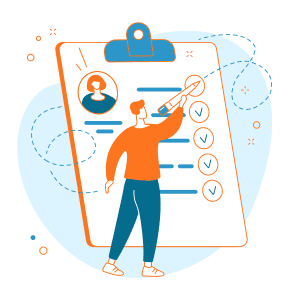Unfortunately, when it comes to workforce management, employee discipline is a very real part of the job. An employee warning notice can be a crucial element of the HR and management landscape. Yet, understanding when and how to use them effectively can be a challenge.

Personnel Today surveyed employers around the most common issues that lead to disciplinary action. 93% of those surveyed reported that the most common issue raised as the subject of a formal disciplinary hearing would be “general misconduct”, with 43% saying this was frequent and 50% describing it as occasional. General misconduct is a very common reason for employers to give out employee warning notices. In this comprehensive guide, we will dive deep into what an employee warning notice is, its importance, when to issue one, and the key elements to include. We’ll also explore some best practices for issuing such notices.
What is an Employee Warning Notice?
An employee warning notice is a formal document that informs an employee about their misconduct or poor performance in their job. This document serves as an official record that the employer has communicated the issue to the employee, giving them an opportunity to improve. It typically includes a detailed account of the problematic behavior or performance, the expected improvements, and potential consequences if improvements are not made.
There is no official wording or template for an employee warning notice, as it will differ from industry to industry. Usually, they are written to keep a record for the employee and employer’s benefit.
The Importance of an Employee Warning Notice
Employers do not just use warning notices to discipline employees. They serve a wider range of benefits. Let’s take a look at the importance of employee warning notices.
Maintaining Professionalism

An employee warning notice serves as an impartial and professional way of handling issues in the workplace. It ensures both parties are aware of the problem and understand the expectations moving forward. This transparent approach fosters an environment of respect and fairness.
Legal Protection
Employment laws protect employees from wrongful termination. In the event of a legal dispute, an employer needs to prove they gave the employee a fair chance to rectify their behavior or performance. An employee warning notice provides evidence of these attempts, protecting the employer from potential legal complications.
A Chance for Improvement
Issuing a warning allows the employee an opportunity to correct their behavior or improve their performance. It sends a clear message that their current conduct is unacceptable while also providing them with a roadmap to get back on track.
When to Issue an Employee Warning Notice
An employee warning notice is not a step to be taken lightly. Employers should issue a warning when there are serious or recurring issues with an employee’s performance or behavior. Generally, these issues have already been clearly communicated to the employee but remain unaddressed. Some examples of such instances could be:

- Repeated failure to meet performance standards
- Regular tardiness or absence without valid reasons
- Violations of company policy
- Unprofessional or inappropriate behavior
It’s crucial to maintain consistency when issuing warnings. This means treating all employees equally, regardless of their role or length of service.
Key Elements of an Employee Warning Notice
An effective employee warning notice should contain several key elements:
Clear Identification
The notice should clearly identify the employee, the issuing authority, and the date of the issue. It should also make it perfectly clear that the document is an employee warning notice.
Description of the Issue
Provide a detailed, objective description of the problematic behavior or performance, including dates and any previous conversations about the issue.
Expected Improvement
Clearly state what the employee needs to do to improve, and set a timeline for this improvement. Be specific about the standards they should meet.
Consequences
Outline potential consequences if the employee fails to improve. This might include further disciplinary action. There are a number of options when it comes to discipline which include suspension without pay, or firing the employee.
Employee Acknowledgement

The employee should sign the notice to confirm they received and understood it. This step is important for establishing a record that the employer has communicated the issue to the employee. This is one step that is often overlooked, but in reality is one of the most important steps.
Best Practices for Issuing an Employee Warning Notice
Be Objective
It’s essential to be objective when writing employee warning letters. Stick to the facts, avoid emotional language, and provide evidence where possible. Remember, this is not an opportunity to air your personal grievances with an employee.
Private Discussion
Before issuing the notice, it’s a good idea to meet with the employee and have a private discussion to explain the problem and potential consequences. This conversation should be empathetic and respectful. Make sure that the employee understands what is happening. Even the act of issuing the notice should be done in private to avoid embarrassment for the employee.
Documentation
Keep a record of all communications and warnings related to the employee’s issue. These records are crucial in case of a legal dispute. Documentation can be kept digitally, or on paper in a physical file.
Follow-Up on the employee warning notice
After issuing the warning, follow up with the employee regularly to monitor their progress and provide additional support or training if necessary.
Conclusion

An employee warning notice is an essential tool for managing performance and behavior in the workplace. Used effectively, it can help maintain a professional environment, protect the employer legally, and provide employees with a fair opportunity to improve. Always ensure that notices are issued fairly and consistently, and include all necessary information. By doing so, you can manage issues in the workplace effectively while promoting a culture of transparency and fairness.
Remember, the primary goal of an employee warning notice is not to punish but to help the employee realize the gravity of the situation, leading to corrective actions and enhanced performance.




